
Knee-Deep Thinking: Why Staying Shallow Holds Us Back
Safe feels easy, but the real growth happens when we wade deeper.


I can still picture it—walking through my northwest Chicago neighborhood with friends, chanting that childhood rhyme: “Don’t step on a crack or you’ll break your mother’s back.” We’d hop, leap, and tiptoe down the sidewalk, dodging every fissure like it was lava. In Chicago, that was no easy feat—those sidewalks were a patchwork of cracks, making the game almost impossible to win.
Lately, I’ve been thinking about that game—not because I’m feeling nostalgic, but because in today’s workplaces, there’s a different kind of crack we’re all trying to avoid. It’s not in the pavement. It’s in our people. And unlike the sidewalks of my childhood, these cracks aren’t visible until it’s too late. They start small, almost invisible—tiny fractures in connection, creativity, and trust—until suddenly, you realize your team is quietly cracking.
I saw it happen with Maya. When I first met her, she was the spark in staff meetings, bubbling with ideas, asking bold questions, and offering creative solutions that pushed projects forward. She wasn’t just doing her job; she was lighting up the room.
But six months later, something had shifted. Maya still showed up. She still met deadlines. Her work was… fine. But she’d stopped volunteering ideas and stuck to the brief. Avoided brainstorming sessions. When I asked how she was doing, she smiled politely and said, “I’m fine. Just busy.” I know we have all used the “I’m fine” line when we are actually not.
Her manager also thought everything was fine. After all, her performance looked solid on paper. But under the surface, Maya was quietly cracking. She hadn’t been challenged in months. No one had acknowledged her creative contributions. The excitement she once brought to her work had quietly drained away.
That’s the thing about quiet cracking, it’s not dramatic. There’s no big confrontation, no apparent collapse. Just a slow erosion of energy and engagement until one day, the spark is gone.
How can leaders recognize and repair quiet cracking before it silently erodes creativity, connection, and performance?
Sure, you can leap over the cracks like I did as a kid, but they don’t disappear. In leadership, those fractures remain, quietly widening. And you can’t lead well if you don’t see them forming—especially if you have no idea what’s causing them.
Quiet cracking is different from burnout. It’s different from quiet quitting. It’s a subtler, slower fade. It’s a disengagement that hides behind “everything’s fine” and “just busy.”
Here’s some research:
A recent survey that brought this term into the spotlight found:
The data lines up with what PeopleInsight found about disengagement:
And here’s where recognition plays a huge role: Zippia’s research shows that nearly 29% of employees receive no recognition at all. Companies with strong recognition cultures have 31% lower turnover and 22% higher profitability. Yet only 22% of managers feel equipped to give meaningful recognition.
The throughline is clear: quiet cracking grows where people feel unseen, underchallenged, and disconnected from purpose.
Creativity and Deeper Thinking? They are the first casualties. When employees are left to simply “do their job” without space to think differently, they lose the spark that makes work worth doing.
Applied Curiosity / Next Steps for Bold Thinkers: The antidote to quiet cracking isn’t just “more engagement.” It’s meaningful connection, intentional creativity, and recognition that matter.
Here’s how to lead differently:
Why it works: Growth signals belief in someone’s potential—and belief is contagious.
Why it works: Recognition says, “I see you. I value you.” That’s the antidote to invisibility and disconnection.
Why it works: Psychological safety fosters a culture that encourages innovation to thrive.
Why it works: Connection fosters a sense of belonging, and belonging in turn fuels commitment.
Why it works: Autonomy communicates trust. Support says, “You’re not alone in this.”
1. The Listening Check-In: In your next 1:1, skip the updates. Ask: “What’s something you’d change about your work if you could?”
2. The Recognition Ripple: Send one specific, values-based note of appreciation today and ask the recipient to “pay it forward” by recognizing someone else this week.
3. The Curiosity Spark: Pose a “What if?” question in your next meeting that’s unrelated to the agenda. “What if we had to solve this with half the budget?”
Maya’s story had a better ending than most. Her manager eventually realized something was off—not from a performance dip, but from the silence. She invited Maya to lead a creative project, recognized her contributions in a public meeting, and talked openly about her career goals. Within weeks, Maya was back in brainstorming, pitching ideas, and smiling like she used to.
Quiet cracking is a warning sign, not a death sentence for engagement. Leaders who lean into curiosity, creativity, and connection can catch it early and reverse it.
Because the best leaders don’t just manage work—they see people, ignite ideas, and make it worth showing up.
Until next time, let’s think deeper.
References
Caldwell, L. (2025). ‘Quiet cracking’ is the newest term for a workplace problem — and it’s pretty pervasive, expert says. The Hill. https://thehill.com/homenews/nexstar_media_wire/5406424-quiet-cracking-is-the-newest-term-for-a-workplace-problem-and-its-pretty-pervasive-expert-says/
Gallup. (2023). State of the global workplace: 2023 report. Gallup. https://www.gallup.com/workplace/349484/state-of-the-global-workplace.aspx
PeopleInsight. (2023). Quiet quitting or disengagement? PeopleInsight. https://peopleinsight.co.uk/quiet-quitting-or-disengagement/
TalentLMS. (2025). Quiet cracking in the workplace survey. TalentLMS. https://www.talentlms.com/research/quiet-cracking-workplace-survey
Zippia.com. (2023). 25 employee recognition statistics [2023]: How to boost productivity. Zippia. https://www.zippia.com/advice/employee-recognition-statistics/
Share Post:

Safe feels easy, but the real growth happens when we wade deeper.

A lighthouse doesn’t shine just for decoration; it exists because lives depend

A Beacon on the Shore We’re drowning in information and starving for